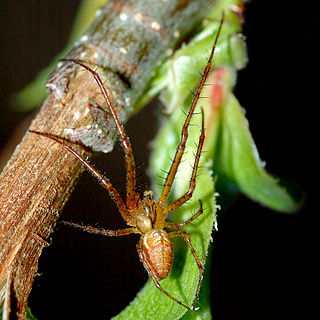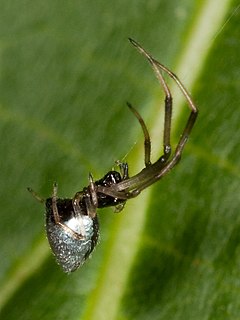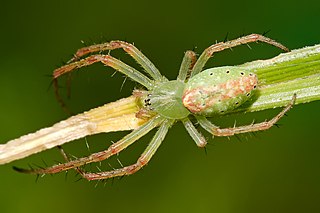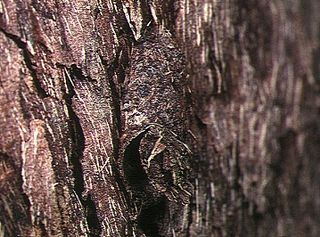
The genus Argiope includes rather large spiders that often have a strikingly coloured abdomen. These spiders are distributed throughout the world. Most countries in tropical or temperate climates host one or more species that are similar in appearance. The etymology of Argiope is from a Latin word argentum meaning silver. The carapace of Argiope species is typically covered in silvery hairs, and when crawling in the sun, they reflect it in a way that gives them a metallic, white appearance.

Orb-weaver spiders are members of the spider family Araneidae. They are the most common group of builders of spiral wheel-shaped webs often found in gardens, fields, and forests. The English word orb can mean "circular", hence the English name of the group. Araneids have eight similar eyes, hairy or spiny legs, and no stridulating organs.

Long-jawed orb weavers or long jawed spiders (Tetragnathidae) are a family of araneomorph spiders first described by Anton Menge in 1866. They have elongated bodies, legs, and chelicerae, and build small orb webs with an open hub with few, wide-set radii and spirals with no signal line or retreat. Some species are often found in long vegetation near water.

Myrmarachne is a genus of ant-mimicking jumping spiders that was first described by W. S. MacLeay in 1839. They are commonly called antmimicking spiders, but they are not the only spiders that have this attribute. The name is a combination of Ancient Greek μύρμηξ, meaning "ant", and ἀράχνη, meaning "spider".

Gasteracantha is a genus of orb-weaver spiders first named by Carl Jakob Sundevall in 1833. The females of most species are brightly colored with six prominent spines on their broad, hardened, shell-like abdomens. The name Gasteracantha is derived from the Greek gaster (γαστήρ), meaning "belly, abdomen", and akantha (άκανθα), meaning "thorn, spine". Spiny-backed orb-weavers are sometimes colloquially called "crab spiders" because of their shape, but they are not closely related to the true crab spiders. Other colloquial names for certain species include thorn spider, star spider, kite spider, or jewel spider.

Thiania is a genus of jumping spiders that was first described by Carl Ludwig Koch in 1846.

Argyrodes, also called dewdrop spiders, is a genus of comb-footed spiders that was first described by Eugène Louis Simon in 1864. They occur worldwide, and are best known for their kleptoparasitism. They can spin their own webs, but tend to invade and reside in their hosts' webs. This relationship can be commensal or even mutual if the dewdrop spider feeds on small trapped insects that are not eaten by the host. Some species can even prey upon the host.

Selenocosmia is a genus of tarantulas that was first described by Anton Ausserer in 1871. The genus is found in China, New Guinea, Indonesia, Australia, Indonesia, Myanmar, Malaysia, Laos, Vietnam, Phillippines and Pakistan. They are commonly referred to as whistling or barking spiders, due to their ability to stridulate using lyra hairs.

Cyrtophora, the tent-web spiders, is a genus of orb-weaver spiders first described by Eugène Simon in 1895. Although they are in the "orb weaver" family, they do not build orb webs. Their tent-like, highly complex non-sticky web is sometimes considered a precursor of the simplified orb web. These webs are aligned horizontally, with a network of supporting threads above them. These spiders often live in colonies. Females have a body length of mostly about 10 millimetres (0.39 in) long. Some members, including Cyrtophora cicatrosa, exhibit the ability to change colour rapidly.

Tetragnatha is a genus of long-jawed orb-weavers found all over the world. It was first described by Pierre André Latreille in 1804, and it contains hundreds of species. Most occur in the tropics and subtropics, and many can run over water. They are commonly called stretch spiders in reference to their elongated body form and their ability to hide on blades of grass or similar elongated substrates by stretching their front legs forward and the others behind them. The name Tetragnatha is derived from Greek, tetra- a numerical prefix referring to four and gnatha meaning "jaw". Evolution to cursorial behavior occurred long ago in a few different species, the most studied being those found on the Hawaiian islands. One of the biggest and most common species is T. extensa, which has a holarctic distribution. It can be found near lakes, river banks or swamps. Large numbers of individuals can often be found in reeds, tall grass, and around minor trees and shrubs.

Dolichognatha is a genus of tropical and subtropical long-jawed orb-weavers that was first described by Octavius Pickard-Cambridge in 1869. Originally placed with the Archaeidae, it was transferred to the Araneidae in 1967, and to the Tetragnathidae in 1981.
Pinkfloydia is a genus of small Australian long-jawed orb-weavers, reaching a maximum lengths of about 4.5 millimetres (0.18 in). It was first described by D. Dimitrov & G. Hormiga in 2011, and contains two species, found in New South Wales and Western Australia: P. harveyi and P. rixi. They have a unique rounded, cone-shaped head structure with one pair of large eyes and three pairs of smaller eyes. The genus is named after British rock band Pink Floyd.

Tylorida is a genus of long-jawed orb-weavers that was first described by Eugène Louis Simon in 1894.

Conothele is a genus of mygalomorph spiders in the family Halonoproctidae, first described by Tamerlan Thorell in 1878. Originally placed with the Ctenizidae, it was moved to the Halonoproctidae in 2018.
Mesida is a genus of long-jawed orb-weavers that was first described by Władysław Kulczyński in 1911.

Nanometa is a genus of long-jawed orb-weavers containing the fifteen species. It was erected by Eugène Louis Simon based on the type specimen of Nanometa gentilis found in 1908. It is included in a clade of its own defined by nine morphological synapomorphies, along with the genus Orsinome.

Hygropoda is a genus of nursery web spiders that was first described by Tamerlan Thorell in 1894.














